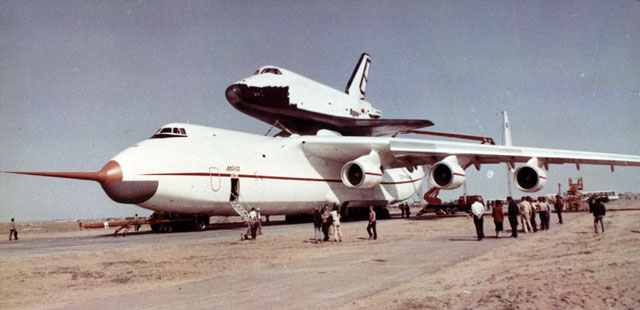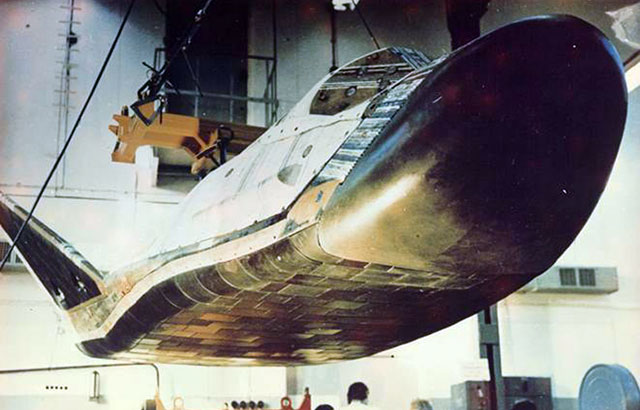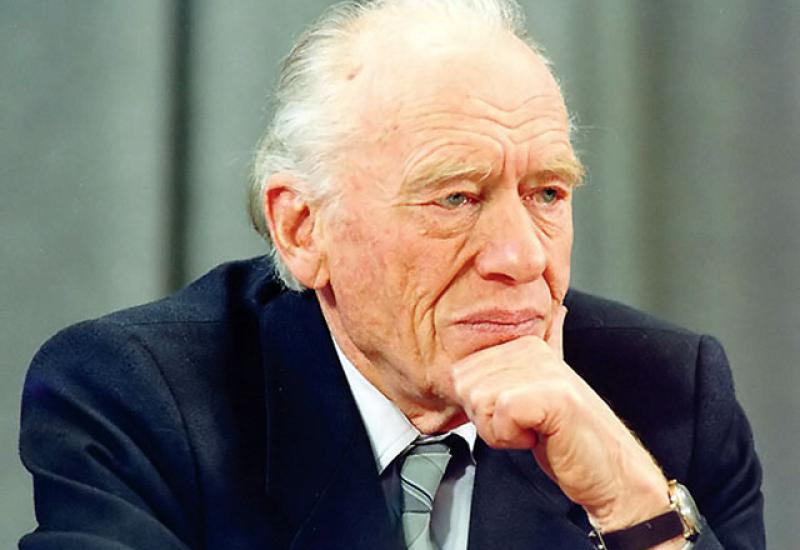December 25, 2009 a native of Kiev, Hero of Socialist Labor, laureate of Lenin and Stalin Prize, General Designer of SPA "Molniya", one of the most prominent developers of Soviet aerospace engineering Gleb Lozino-Lozinskiy would have turned 100 years old.He began working in the aviation industry as an expert on engines, has created the country's first afterburner for turbojet. He was the project manager of "Spiral", reusable space system "Energia-Buran", reusable aerospace system "MAX", the author of dozens of other projects. He was directly involved in the creation of a series of MiG-19, MiG-21, MiG-25, MiG-29, MiG-31. Throughout his career, he did not break with Ukraine, supporting and developing with it a lot of creative communications.
"... For many, the answer to the question with which we go into the new millennium - is obvious. Loaded numerous problems and hope for their favorable resolution. But we would have to go with the idea of the stunning complexity and generosity of the results that can unite people in the world, filled with special meaning of life for many generations. I am convinced that this idea can be associated only with the cosmos. Mankind will never be on the ground ... ". This task outstanding designer, Hero of Socialist Labor, the head of one of the most ambitious projects of the twentieth century, which was attended by experts from all over the Soviet Union, Gleb Lozino-Lozinskiy devoted his entire life.
Creation of a reusable space system "Energia-Buran" was a landmark event in the history of Russian rocket and space technology. Thirty years have passed after the breakthrough flight winged spacecraft OS "Buran" deployed by the carrier rocket "Energy". The message of the triumph of the Soviet space program TASS wrote: "November 15, 1988 at 9:25 am Moscow time, orbital ship" Buran "performed two spiral flying in an orbit around the earth, landed on runway Baikonur Cosmodrome. The world's first landing was carried out in an automatic mode. Pilot program starting universal rocket and space transportation system "Energy" and orbital shuttle "Buran" fully implemented ".
The development of one of the most important parts of this project was entrusted to the Ukrainian specialists. Gleb Evgenovich never forgot about his Ukrainian roots and was proud of it. An interesting detail: at the congress in Munich, he did not begin his speech without the flag of Ukraine near the Russian flag.

Presenting Moscow Mayor Luzhkov Ukrainian model "Mria" with "Buran" on the "back", he said that out of nearly a thousand organizations involved in the creation of the aircraft, 70% are from Moscow, but teams of Ukraine did the large amount of work too. They were Kharkiv SPA "Hartron", which created a system of management of the entire space system, and the Kiev Polytechnic Institute, namely the group of Professor V.Slipchenko that developed software for test benches and simulators.
It should be noted that by the end of the project of the universities there were only KPI, Moscow State University, Moscow Aviation Institute and Tomsk Polytechnic Institute.
The following researchers of the KPI became laureates of State Prize of the USSR in 1988: G. Dementiev, V. Fedorov, V. Slipchenko, V. Pereverzev, O. Gagarin, A. Yasko, G. Elisarenko, V. Senchenko, A.Karimov, A. Koval.
Project participants recall that work was carried out in secrecy. And it began with the fact that the academician A.Kuhtenko of the Institute of Cybernetics offered to employees of the department of computer engineering and engineering calculations KPI to program one fragment of the dynamics of a complex object of a heavy aircraft. The equations were simple enough, but the difficulty was that everything should be done in real time, and that in those years almost nobody did – there were not sufficiently enough powerful computers. However, the task was successfully solved and scientists KPI joined the members of one of the most brilliant projects of the late twentieth century. They have created a software for test benches, which tested the system and future spacecraft simulators to train future pilots. Tests were carried out on the machines Kiev factory "Electronmash." The flight was simulated on that bench, while “Buran”, mounted on this bench, should respond to changing conditions in space. Only in this way it was possible to verify the correctness of programs, which are then installed in the equipment of the aircraft. The scientists from Kiev had an opportunity to move in Moscow and work in the SPA “Molnia", but they preferred the Kiev Polytechnic.
If not the war, Lozino-Lozinski, the son of Ukrainian lands also would have stayed in Kiev. However, life turned out differently. Gleb Evgenovich said about it: "Almost all of the major turning points in my life were caused by a chain of coincidences. I should only had to make a decision, relying on their intuition."
He said about an important turn in his life, which established the involvement G.Lozino-Lozinski to the creation of aerospace systems in A. Mikoyan Design Bureau: "Hitler put me out of Kiev, and an accident led to the Mikoyan." As a result, he has worked in DB 35 fruitful years.
All this was preceded by training at the Kharkov Institute of Mechanical Engineering, and then - the successful work of engineering calculators on the Kharkov Turbine-generator plant. This company has created an unprecedented turbine power at the time - 50-100 MW. Today, this plant is called "Turboatom" and is one of the world's largest turbine construction plants.
In the early 1930s G.Lozino-Lozinski was invited to Kharkov Aviation Institute to participate in the creation of steam power engine with a capacity of 3000 hp for bomber Tupolev. In the prewar years Lozino-Lozinski, together with M. Gindes put forward a number of promising ideas. In particular, it was the idea of creating a steam power unit operating on a piston engine exhaust gases. In 1937-1938, Lozino-Lozinski and M. Gindes and Lyulka, a graduate of the KPI, the future famous designer of aircraft engines, one of the founders of the theory air jet engines, grounded the possibility of creating a gas turbine engine, which marked the beginning of a new era in the development of jet aircraft .
In February 1941, the paths of A. Lyulka and G. Lozino-Lozinski diverged, joining again only in 1965, when A.Lyulka began creating steam power TJE for aerospace "Spiral" Lozino-Lozinski ...
Before the war, the chief designer of the Kiev Aviation Plant №43 V.Tairov invited Lozino-Lozinski to work in a DB of the factory for the construction of maneuverable fighter OKO-4. But June 25, 1941 the factory was bombed. In early July, the family-Lozino Lozinski went from Kiev, so the fate led him to the A. Mikoyan Design Bureau.
Since February 1942 in the Moscow Gleb Evgenovich continued to work in A. Mikoyan Design Bureau, and his achievements were impressive. In the active of the designer - the various versions of turbine engines. After reaching record levels in engine came to the fore the problem of creating high-performance serial fighter. G.Lozino-Lozinsky headed in the Design Bureau V.Mikoyan work on complex merging the engine with air intake and afterburner in order to increase the efficiency of the entire power unit. The result was a MiG-19 - the world's first serial supersonic fighter. It was replaced by the best fighter of that time MiG-21. In a result the powerful and well-honed power unit has become one of the major factors that provide benefits Mikoyan fighter planes over potential adversaries.This clearly demonstrated the postwar local conflicts: the average loss ratio in Vietnam from 1966 to 1970 between Soviet and American fighters was 3.1: 1 in favor of the MiG-21. For participation in the development of three "mach" fighter-interceptor MiG-25 Gleb Lozino-Lozinskiy was awarded the title of Hero of Socialist Labor.

In 1968, at a meeting of the Military-Industrial Commission of the Council of Ministers of the USSR, Ministry of Defense was mandated to formulate requirements for new generation fighter, which had to replace the MiG-21, MiG-23, Su-9, Su-11 and Su-15. The challenge for the creation of a new aircraft under the code of the MiG-29 was received by the Mikoyan design bureau.
His full-scale development began in 1970. The MiG-29 was equipped with a conventional mechanical control system, as the base model F-15, but had maneuverability even better than the "electric» F-16. Serial production of the MiG-29 began in 1982, and in 1983 the first fighters entered the Air Forces of the USSR.
In 1971 G.Lozino -Lozinski was appointed chief designer of the supersonic MiG-31. The plane was designed for use in air defense system of the country with a view to long patrols and combating all classes of air targets, including cruise missiles, helicopters and high-speed high-altitude aircraft, at any time, in difficult weather conditions, with vigorous conduct of electronic warfare.
With further increase in speed and altitude aircraft entered the threshold of space. In the early 60-ies in the United States the experimental rocket plane X-15 was built and started first flights.
In response, the Soviet Union was put forward a five-year plan Thematic Air Force to build orbital and hypersonic aircraft. In 1965, these projects were given to A. Mikoyan EDB-155, where a 55-year-old chief designer of EDB G.Lozino Lozinski led them.The project of two-stage air-space system (ASS) was named “Spiral”. Unfortunately, the program "Spiral" had no further development, although in all respects was superior to American projects.
In 1972, in the United States the work on the creation of reusable spacecraft "Space Shuttle" (space shuttle) begun, which was intended for military control of the territory of the USSR space. The Cold War was gaining momentum. In the Soviet Union in 1974 it was launched a similar domestic system. V.Glushko as chief designer of SPA "Energy", headed the creation of heavy transport and space system with reusable orbital spacecraft.
February 12, 1976 it appeared the secret government decree of the USSR №132-51 «On the creation of reusable space systems as part of the booster, orbital plane, orbital transfer tug-ship, complex control system, the starting and landing, repair and recovery systems and other ground facilities, which provide launching on the north-eastern orbital altitude of 200 km payloads weighing up to 30 tons and the return from orbit loads weighing up to 20 tonnes. " Subsequently, the reusable space system was called the "Energia-Buran". Responsible for the creation of the airframe of the orbital plane and coordination of all departments of the aviation industry was appointed specially created Scientific-Production Association "Molniya" headed by General Director - Chief Designer Gleb Lozino-Lozinskiy. As a result of years of work it was created a air-space ship. For a long time there were no its analogues in the world practice.
Thinking about the future, G. Lozino-Lozinski foreshadowed "Shuttle" project life up to 2015 – 2020. He considered this program very expensive, and air-launched project "Mriya-MAX" - more promising. He was sure that it will be Ukrainian-Russian project, and said: "it is based on" Mriya "Russia itself could not raise. If only we have agreed to combine our efforts ... ". But this did not happen.
1998, the tenth anniversary of the launch "Buran", he was named an incorrigible optimist for confidence in the recovery of joint work, to which he replied: "Sooner or later they will have to continue if both states are thinking to expand the use of space.
There are several reasons that cannot do without moving start. One - the fundamental associated with the increase in the volume of information received by space telecommunication systems. I have no doubt that we need to do multiple transport systems, which provide the conquest of the space environment on the basis of the principles used in the "Buran". We were ordered an orbital missile carrier, but we made a unique multifunctional ship. I formulated my credo: wing man ensured man with the conquest of the atmosphere, providing use of space and to his advantage. Who is stronger in space, stronger in the world ... "

